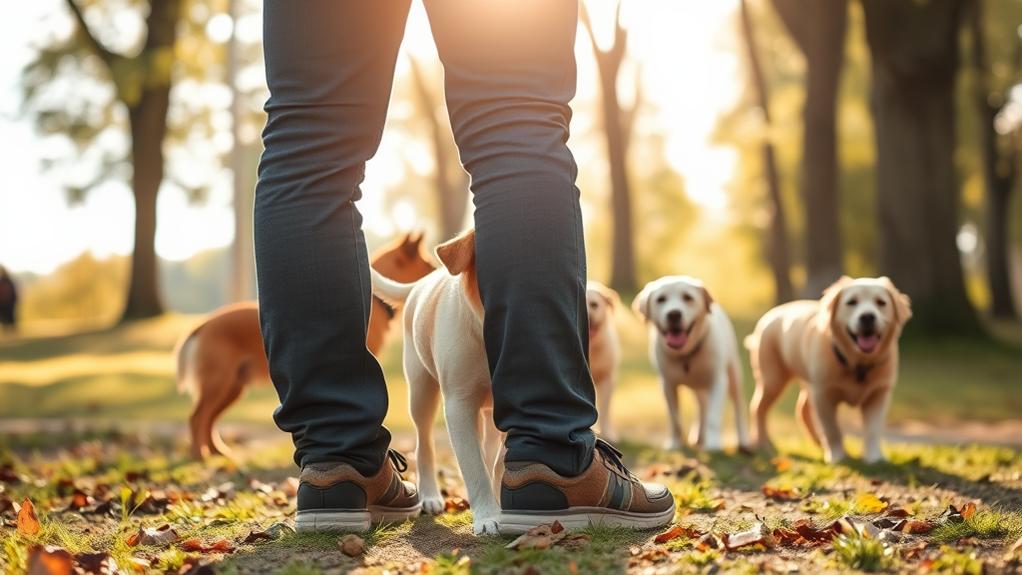If you've got a fearful dog, you know how challenging it can be to help them socialize confidently. It starts with understanding their behavior and recognizing the signs of fear, which can often be subtle. By creating a secure environment and gradually introducing them to new experiences, you can foster their comfort and trust. Incorporating positive reinforcement is essential, but it's important to keep an eye on their progress. What strategies can you employ to guarantee each step forward truly counts?
Understanding Fearful Behavior
Many dogs experience fear in various situations, and understanding this behavior is essential for effective socialization. Fear can stem from a range of factors, including past trauma, lack of exposure to certain environments, or even genetic predisposition.
When you recognize that your dog's fearful responses may be rooted in these experiences, you can approach socialization with empathy and patience.
It's important to remember that fear isn't a sign of weakness but a natural instinct. Your dog might feel threatened by unfamiliar sounds, sights, or even other animals. This instinct can lead to avoidance behaviors or aggressive reactions if they don't feel safe.
As a responsible dog owner, you'll want to create a secure environment where your dog can gradually face their fears.
You can help your dog navigate fearful situations by providing consistent support. Encourage positive experiences in new settings, and allow them to explore at their own pace.
Understanding your dog's specific triggers is key; this awareness allows you to tailor your approach. With time and the right strategies, you can help your dog build confidence, making socialization a more enjoyable experience for both of you.
Signs of Fear in Dogs
Recognizing the signs of fear in your dog is vital for effective socialization. Dogs communicate their feelings through body language, and being aware of these signals can help you respond appropriately.
Look for signs like cowering or shrinking away from people or other dogs. If your dog's tail is tucked between its legs, it's likely feeling scared. Ears pinned back against the head and a lowered body posture are also common indicators of fear.
You might notice your dog avoiding eye contact or trying to hide behind you. Excessive panting, whining, or barking can signal anxiety too. If your dog tries to escape or seeks a retreat, it's a clear sign that it's feeling overwhelmed.
Additionally, some dogs may exhibit aggressive behaviors, such as growling or snapping, as a way to cope with fear. It's essential to recognize these signs early on to prevent escalation.
Creating a Safe Environment
Creating a safe environment for your fearful dog is crucial in helping them feel secure and comfortable. Start by designating a quiet space in your home where your dog can retreat when they feel overwhelmed. This area should be free from loud noises and distractions, allowing your dog to relax and recharge.
Make certain to provide comfortable bedding, toys, and water in this safe zone. You can also use a crate if your dog finds it comforting, but it should never be a place of punishment. Confirm that the crate is a positive space by allowing your dog to enter and exit freely.
Limit exposure to stressful situations, like loud parties or chaotic environments, until your dog feels more confident. When introducing new people or pets, keep interactions calm and controlled. Use a leash and maintain a safe distance until your dog shows interest or curiosity.
Lastly, keep your dog's routine consistent. Regular feeding, walking, and playtime can help establish a sense of normalcy, making your dog feel more secure.
Gradual Exposure Techniques
Gradual exposure techniques can be a game changer for helping your fearful dog socialize. This method involves slowly introducing your dog to new experiences, environments, and other dogs at a pace they can handle.
Start by identifying what specifically frightens your dog—be it loud noises, unfamiliar people, or other pets—and create a plan to expose them gradually.
Begin with low-stress situations. For example, if your dog is scared of other dogs, you might start by observing them from a distance during a walk. As your dog becomes more comfortable, you can slowly decrease the distance over time.
Always pay attention to your dog's body language; signs of stress indicate it's time to take a step back.
You can also use familiar places for exposure. Take your dog to a local park during quieter hours, allowing them to observe their surroundings without feeling overwhelmed.
Gradual exposure isn't about pushing your dog too quickly; it's about building their confidence step by step. With patience and consistency, you'll help your fearful dog learn that the world isn't as scary as it seems.
Positive Reinforcement Strategies
Building trust is essential when helping fearful dogs socialize, and positive reinforcement strategies can play a crucial role in this process. By rewarding your dog for positive behaviors, you can encourage them to feel more confident in social situations. Here are some effective strategies you can use:
| Strategy | Description |
|---|---|
| Treats | Use high-value treats to reward your dog for calm behavior around new people or pets. |
| Praise | Verbally praise your dog when they approach or interact positively with others. |
| Clicker Training | Use a clicker to mark desired behaviors, followed by a treat, to reinforce learning. |
| Gradual Desensitization | Introduce your dog to social situations gradually, rewarding them for each small step forward. |
| Playtime | Engage your dog in play with other dogs, rewarding them for positive interactions. |
Monitoring Progress and Adjusting
Monitoring your dog's progress during socialization is essential for ensuring they feel safe and secure. Keep a close eye on their body language and reactions in various situations. You'll want to look for signs of comfort, like relaxed ears and a wagging tail, as well as signs of stress, such as cowering or growling. By noting these behaviors, you can better gauge their comfort level.
After each socialization session, take a moment to reflect on what went well and what didn't. If your dog handled a new environment or interaction positively, celebrate that success! If they seemed overwhelmed, adjust your approach. Maybe you need to decrease the intensity of the exposure or increase the distance between your dog and the source of anxiety.
Don't be afraid to change your strategy. Sometimes, taking a step back and revisiting basic training can help. Small, incremental adjustments can lead to significant improvements over time.
Conclusion
By understanding your dog's fears and using gradual exposure combined with positive reinforcement, you're not just helping them socialize; you're building a deeper bond. It's amazing how a little patience can transform a timid pup into a confident companion. As you navigate this journey together, you might even find that your own confidence grows, too. After all, facing fears—whether canine or human—often leads to unexpected moments of connection and joy.



